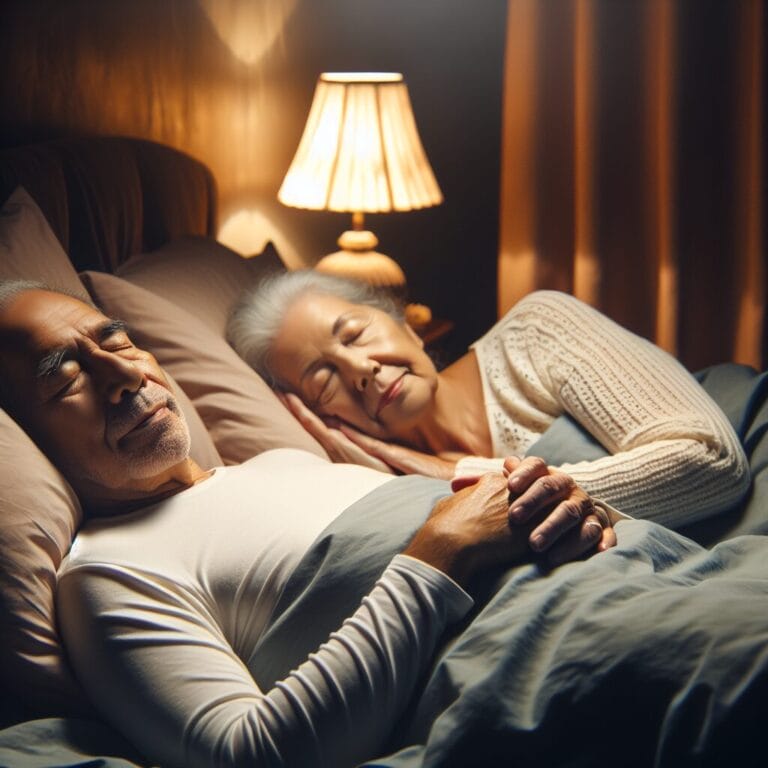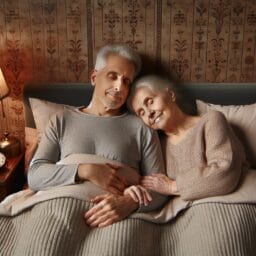
Enhancing Rest: Sleep Optimization Tips for Older Adults with Active Lifestyles
Table of Contents
- Introduction
- Understanding Sleep Patterns in Older Adults
- Lifestyle Adjustments for Better Sleep
- Establishing a Sleep-Conducive Routine
- Medical Interventions and Sleep Aids
- Monitoring Sleep and Making Adjustments
- Conclusion
- Frequently Asked Questions
Introduction
As twilight dips the sky in shades of lavender and rose, older adults often find themselves yearning for a good night’s sleep that may seem as elusive as their younger years. While counting sheep might be a tried-and-true method for some, let’s herd in a few other strategies to ensure our seniors can embrace slumberland with ease. Did you know that engaging in cognitive behavioral therapy specifically designed for insomnia (CBT-I) can work wonders for those golden agers grappling with sleep problems? This non-drug treatment tailors techniques to help initiate and maintain sleep without the grogginess or confusion that over-the-counter medications might bring.
Now, don’t underestimate the power of setting a peaceful ambiance; creating a sleep sanctuary is key! Older patients can deck out their bedrooms with calming scents like valerian, chamomile, or passionflower – all known to help one fall asleep fast and heighten sleep quality. And for those who love a good cuppa before bed, steering clear of caffeine post-afternoon is wise since we want the homeostatic sleep drive running smoothly, not racing like it’s in the Indy 500.
Here’s another interesting nugget: strategic napping! A well-timed nap can bolster the immune system and mental functioning without disrupting nighttime rest. But remember – timing is everything! Napping earlier in the day aligns better with our natural circadian rhythms, preventing any toss-and-turn tussles later at night.
Moreover, eliminating alcohol from evening routines can make significant headway toward overcoming sleep problems. Although that glass of wine might feel relaxing, it could disrupt sleep health more than one realizes—no need to add fuel to heart disease or cognitive impairment’s increased risk fires by impairing restful z’s.
For those nights when thoughts race faster than shooting stars across the sky, relaxation techniques like deep breathing or gentle yoga could lead to much-needed repose. And if sleeping pills are on the nightstand because making Zzzzs has become an uphill battle? It might be time to consult a sleep specialist; after all, prescription drugs should be last on our list due to possible adverse effects on seniors’ health issues.
Above all else, improve sleep habits by sticking to consistent bedtime rituals and wake-up times – yes, even on weekends! With these tweaks and considerations tailored for older adults seeking sound snoozes and dreaming big dreams while they’re at it – rest aging becomes less about laying awake staring at ceilings and more about rejuvenating adventures in dreamland.
| Strategy | Description | Benefits |
|---|---|---|
| Cognitive Behavioral Therapy for Insomnia (CBT-I) | Non-drug treatment to help initiate and maintain sleep. | Improves sleep without grogginess or confusion. |
| Creating a Sleep Sanctuary | Use calming scents like valerian, chamomile, or passionflower and ensure a peaceful bedroom environment. | Helps fall asleep faster and improves sleep quality. |
| Avoiding Caffeine Post-Afternoon | Steer clear of caffeine in the late afternoon and evening. | Supports the homeostatic sleep drive for better night’s rest. |
| Strategic Napping | Take well-timed naps earlier in the day to align with circadian rhythms. | Bolsters immune system and mental functioning without disrupting nighttime sleep. |
| Eliminating Evening Alcohol | Avoid alcohol in the evening routine. | Prevents sleep disruption and reduces risk of heart disease and cognitive impairment. |
| Relaxation Techniques | Practice deep breathing or gentle yoga before bed to calm the mind. | Leads to repose and improves chances of falling asleep. |
| Consulting a Sleep Specialist | Seek professional advice for persistent sleep issues. | Ensures proper treatment and minimizes adverse effects of sleeping pills. |
| Consistent Sleep Habits | Maintain regular bedtime rituals and wake-up times, even on weekends. | Establishes rhythm for better sleep quality and overall rest. |
Understanding Sleep Patterns in Older Adults
Picture this: a world where every older adult leaps out of bed, feeling like a superhero after a night of epic sleep! But hold on; we’re not in dreamland just yet. Real life whispers a secret that not everyone knows—sleep architecture changes as folks get older. Yep, those internal blueprints for shut-eye shuffle around, making deep, restful sleep as tricky to catch as a greased pig at the county fair!
Here’s what happens: When people hit the golden years, they spend less time in that sweet spot known as “deep sleep.” It’s like their brain decides to throw more light-snooze parties instead. And while light snoozing is okay, it ain’t the superhero-grade slumber that keeps you spry and sharp. This architectural shift means seniors may wake up feeling tired even if they’ve been in bed for ages.
Now let’s wiggle into something comfy and chat about staying active because moving more during daylight hours helps set the stage for better zzz’s when stars twinkle above. That’s right; being busy bees with walks or tai chi in the park can tire out bodies just enough so when head meets pillow—boom! Sleep comes knocking faster than grandkids running for ice cream.
But wait, there’s more! The sneaky villains of this story are sleep disorders that love to mess with older adults’ nights. Take sleep apnea—it’s no joke and can have folks gasping instead of dreaming. Or restless legs syndrome that jitters limbs and tells ’em to dance when it should be quiet time. These troublemakers don’t just steal away good nights’ rest; they can also swipe away daytime sparkle and make remembering things tougher than learning pig Latin.
So, what can these wonderful wise ones do? They gotta check in with a sleep specialist who knows their stuff about these nighttime nuisances. Doc will peek under the hood (so to speak) and might suggest some snazzy gadgets or tips to keep air flowing or legs still so everyone can sail smoothly on dream seas.
Let us not forget the essentials: improving sleep habits by winding down right as dusk slips into nightfall—a warm bath or reading under soft lamplight could be your ticket to cozy town. Add some blackout curtains for an extra snug environment and consider giving caffeine the cold shoulder later in the day – it loves partying late but isn’t such a good friend when you want peace and calm.
Imagine kicking those pesky sleep problems out the door – how grand would that be? A life full of energy awaits seniors ready to grab it by turning these dreams into reality!

Lifestyle Adjustments for Better Sleep
Did you know that the very environment where older adults rest their heads can work like a charm (or a spell of restlessness) when it comes to catching those elusive Zzz’s? Yes, sirree, creating a sleep-conducive space is like setting up a cozy bear den for hibernation; it’s all about the comfort and vibe. Picking out the perfect pillow – not too puffy, not too flat – and mattresses that cradle you just right can transform beddy-bye time into a nightly vacation. And let’s talk room conditions – think cool, dark, and quiet. Imagine using shades darker than a starless night sky and setting the thermostat to ‘cool mountain breeze’ to turn your bedroom into the ultimate sleep cave.
Now, mosey on over to the dinner table because what older adults feast on can either be tickets to dreamland or sneak thieves of slumber. Foods rich in magnesium like spinach – Popeye was onto something! – or cherries with natural melatonin might as well be PJs for your insides, ushering in sweet dreams before heads hit pillows. But beware of sneaky caffeine hidden in chocolate or heartburn-inducing spicy tacos which could keep them counting more ceiling tiles than sheep!
And hey, let’s get moving (but at the right time)! Exercise isn’t just about sporting snazzy leggings; it helps tire you out so when it’s snooze-o’clock, bodies are ready to shut down faster than a laptop on 1% battery. But timing is as key as finding comfy sneakers: morning stretches under the sunbeams or an afternoon stroll can leave older adults glowing with health and ready to embrace sleep later on.
Lacing up these strategies with golden threads of habit – same bedtime routine anyone? – ingrains patterns deeper than footprints in wet cement. This regularity means internal clocks tick-tock better than Big Ben, syncing sleepy times with body rhythms so twilight hours aren’t spent listening to silence but instead visiting dreamscapes where adventures await.
So there we have it: cushioned nests for beds, plates filled with sleep-friendly munchies (hold off on midnight snacks!), daytime body wiggles that lead to nighttime nods-off—all paving the way toward nights full of restful dozing rather than tossing-turning marathons. With these pearls of wisdom tucked under their pillows, our beloved seniors can look forward to good nights’ rests that leave them spry as spring chickens come sunrise!
Establishing a Sleep-Conducive Routine
Did you know that a whopping one-third of our lives is spent in the land of nod? That’s right! Sleep isn’t just a nice-to-have; it’s as vital as water for teatime. For older adults, sticking to a regular bedtime isn’t about being a party pooper; it’s about keeping that circadian rhythm—your body’s internal clock—as steady as a metronome. When this rhythm twirls in time, it signals your brain to release sleepy-time chemicals like melatonin when the stars come out, helping you glide into dreamland on time every night.
Now, imagine turning pre-sleep moments into a relaxation fiesta! Techniques like gentle stretching or mindfulness meditation can be like a warm hug for your nervous system, setting the stage for restful sleep. Think of them as soft lullabies steering your mind away from the day’s hustle-bustle and into tranquility mode. Sipping on some warm milk spiked with honey might sound old school, but hey, if it paves the way to snoozeville, why not give it a whirl?
However, just before we slip under those cozy covers, let’s chat about pesky screen time. Those glowing gadgets are more than shiny distractions; they’re blue-light beams telling our brains to wakey-wakey when we should be winding down. So flipping through late-night TV shows or scrolling social media might leave you buzzing rather than snuggling up with Mr. Sandman.
It’s not all about what happens at night though; how we spend our days counts too. Keep afternoons bright and lively but dial down excitement several hours before bed – trust me, doing crossword puzzles under the covers won’t win you any sleep trophies.
By marrying these slumber strategies together—stable sleep schedules, evening calm-down rituals minus screens and excitement—we tee up older folks for nights brimming with quality shut-eye. This means waking up sprightly and ready to dance through their days with vim and vigor because let’s face it: great days start with good nights’ rests!
Medical Interventions and Sleep Aids
Did you ever wonder what the buzz is all about with milk and honey before bed? Well, it turns out this cozy concoction has its roots in sleep science, especially for older adults! Sipping on this sweet mixture can be just the nudge their bodies need to trip the sleep switch. But beyond warm beverages, there’s a world of non-drug treatments that are catching many Zzz’s without counting sheep. Cognitive-behavioral therapy for insomnia (CBT-I), for instance, is like having a personal trainer for your brain, coaching it into snooze mode by replacing worry with relaxation.
Older patients sometimes face the conundrum of considering sleeping pills. While these medications may seem like a quick fix, they’re not a one-size-fits-all—especially when side effects loom larger than life. It’s important to weigh the grogginess and confusion against the benefits, consulting health experts to assess if prescription drugs or over-the-counter options are truly needed or if lifestyle tweaks could do the trick.
For those skeptical about medication’s helping hand, nature pitches in! Herbs like valerian chamomile passionflower aren’t just names of enchanting forest fairies; they’re natural supplements known to seduce sleep without any chemical courtship. These botanical buddies can help maintain sleep and send both homeostatic drive and restlessness packing.
If older folks find themselves twisting and turning at night, haunted by trouble sleeping despite counting more stars than a galaxy tour guide, it might be time to ring up a sleep specialist. These maestros of slumber know how aging can affect sleep and can orchestrate a symphony of strategies tailored to each person’s needs. They’ll look into how heart disease or cognitive impairment increased risk could disrupt sleep health and whether eliminating alcohol caffeine from evening routines is necessary.
So yes, getting a good night’s rest isn’t always as simple as hitting the hay; sometimes it involves being savvier about our snoozing solutions. From improving sleep habits with consistent schedules to exploring non-drug treatments before hopping aboard the medication express—there’s a bounty of options for old-timers keen on embracing Mr. Sandman instead of wrestling restless nights away.
Monitoring Sleep and Making Adjustments
Imagine this: older adults becoming super-sleuths in their quest for the perfect slumber! By keeping a sleep diary, our wise friends can become detectives of dozing, tracking their snooze patterns and pinpointing what makes sleep sneak away. It’s like having a personal bedtime story where they’re both the hero and the author, writing down their nightly escapades to discover what works best for drifting off dreamily.
But wait, there’s more on the horizon of high-tech helpers! From smartwatches that monitor heart rates to beds that adjust firmness based on your sleep stages —the latest gadgets are transforming bedrooms into futuristic sleep labs. These nifty devices give older patients real-time feedback on their slumber quality, making it easier than trying to catch a greased pig at bedtime!
And here’s the pro tip: just like updating software on a computer, regular evaluation of sleep strategies is a must. Our bodies change over time, so what made us nod off at 65 might not work as effectively at 75. Adjust those pillows, tweak those routines and maybe even switch out lavender for valerian chamomile passionflower scents – stay flexible and keep your eyes peeled for new ways to invite Mr. Sandman over!
So let’s empower our magnificent mature crowd with this dynamic duo: penning down pillow thoughts in a diary and using tech tools tailor-made for them. With these allies by their side, they can conquer restless nights and take charge of their twilight hours—because everyone deserves a good night’s rest filled with sweet dreams and starry skies!
Conclusion
Picture it: a world where our cherished older folks hit the hay and drift off just like kids on Christmas Eve, no counting sheep needed! To get there, they might look into new lullabies from technology. Sleep-tracking apps and wearable gadgets are like secret agents for snooze, giving deep intel on how to boost those Zzzs. Plus, keeping sleep spaces cooler than a cucumber and darker than midnight can work wonders for inviting dreamland’s visit. And let’s not forget about zenning out with relaxation techniques that are as soothing as grandma’s bedtime stories. Older adults deserve every ounce of restful sleep; it rejuvenates brains and bodies alike, keeps them dancing through their golden years, and wards off pesky sleep stealers like apnea or anxiety. So here’s to the tireless pursuit of that perfect night’s slumber – because every good day starts with a good night’s sleep!




